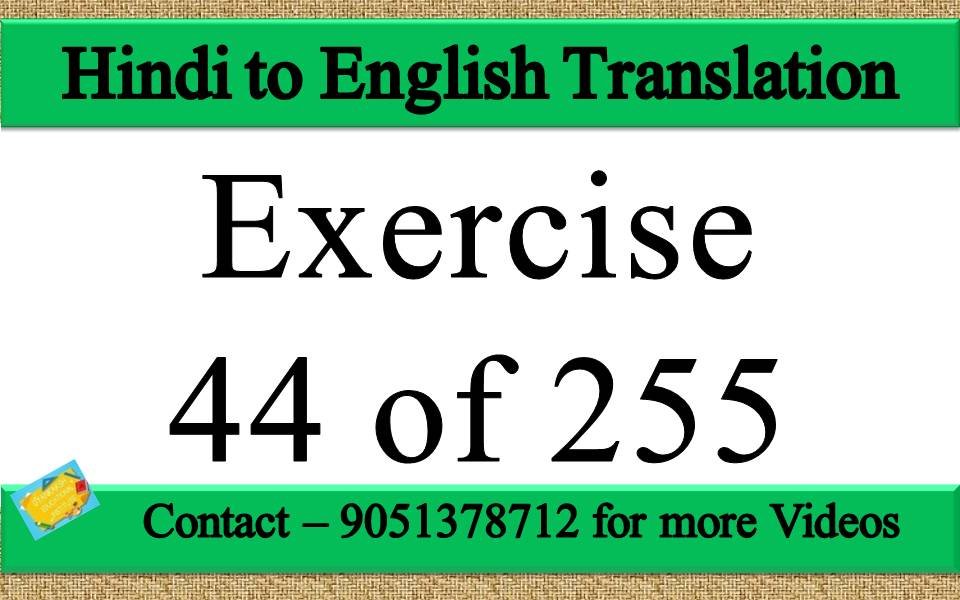"Mastering Translation: Unleash Your Skills with Hindi to English Translation Exercise 44"
Hindi to English Translation Course में आपका स्वागत है। इस Course में हम आपको 255 Exercises Solve करवाएंगे। अगर आप सभी Hindi to English Translation Exercise Solve करना चाहते है तो 9051378712 में सम्पर्क करें।
We have given you 255 classes on Hindi to English Translation Exercises. This is Hindi to English translation Exercise 44. You should watch the YouTube video first and then practice the sets given below. If you want proper improvement then practice by writing these sets in your copy and then study them regulary.
In every practice set you will get many examples on Hindi to English Translation Exercises with exercises, vocabulary and explanation.
We have given many course on Spoken English in our website. You can get them from the menu section.
Table of Contents (Hindi to English translation)
Hindi to English Translation Exercise 44 of 255
Do Hindi to English Translation:
यह (एक) गाय है।
वह (एक) बैल है।
यह (एक) अमरूद है।
वह (एक) सेब है।
यह (एक) केला है।
वह (एक) अंडा है।
यह (एक) गिलास है।
वह (एक) छाता है।
यह (एक) कलम है।
वह (एक) दवात है।
यह (एक) घोड़ा है।
वह (एक) हाथी है।
यह (एक) भैंस है।
वह (एक) गदहा है।
यह (एक) बकरी है।
वह (एक) चींटी है।
यह (एक) कौआ है।
वह (एक) उल्लू है।
यह (एक) चाकू है।
वह (एक) कुल्हाड़ी है।
मैं (एक) लेखक हूँ।
तुम (एक) कवि हो।
वह (एक) अभिनेत्री है।
मैं (एक) शिक्षक हूँ।
आप (एक) कलाकार हैं।
वह (एक) अफसर है।
मैं (एक) भारतीय हूँ।
तुम (एक) हिंदू हो।
वह (एक) अंग्रेज़ है।
हम (लोग) भारतीय हैं।
तुम लोग हिंदू हो।
वे (लोग) अंग्रेज़ हैं।
यह चाय है।
वह पानी है।
यह आटा है।
वह तेल है।
यह सिरका है।
यह विनय है।
वह निशा है।
मैं अजय हूँ।
तुम विजय हो।
Note: वाक्य में ‘एक’ रहे या न रहे, अंग्रेज़ी अनुवाद में Singular Common Noun के पहले a / an का व्यवहार सामान्य अर्थ में अनिवार्य है।
Download our Mobile App from Google Play Store – Gyankaksh Educational Institute.
Vocabulary for Hindi to English Translation Exercise 44 of 255:
दवात – inkpot,
उल्लू – owl,
कुल्हाड़ी – axe,
लेखक – writer,
कवि – poet,
अभिनेत्री – actress,
कलाकार – artist,
अंग्रेज़ – Englishman,
आटा – flour,
सिरका – vinegar.
Spoken English Course (Beginner level to advance level) 2500+ Videos
- Use of Articles
A, An, The को Articles कहा जाता है।
Type of Articles:
1. Definite Article
2. Indefinite Article
Articles दो प्रकार के होते हैं:
- Definite Article
- Indefinite Article
The को Definite Article कहा जाता है। A / An को Indefinite Article कहा जाता है।
- Use of A / Use of An
A / An को Indefinite Article कहा जाता है क्योंकि इससे किसी निश्चित व्यक्ति / वस्तु का नहीं, बल्कि किसी अनिश्चित व्यक्ति / वस्तु का बोध होता है।
नीचे के वाक्यों को ध्यान से पढ़ें:
1. मैं (एक) चिकित्सक हूँ। | I am a doctor. I’m a doctor.
|
2. हम (लोग) चिकित्सक हैं। | We are doctors. We’re doctors.
|
3. आप (एक) अधिवक्ता हैं। | You are an advocate. You’re an advocate.
|
4. आप लोग अधिवक्ता हैं। | You are advocates. You’re advocates.
|
5. वह (एक) शिक्षक है। | He is a teacher. He’s a teacher.
|
6. वे (लोग) शिक्षक हैं। | They are teachers. They’re teachers.
|
7. तुम (एक) अफ़सर हो। | You are an officer. You’re an officer.
|
8. तुम लोग अफ़सर हो। | You are officers. You’re officers.
|
9. यह (एक) आम है। | This is a mango.
|
10. ये आम हैं। | These are mangoes.
|
11. वह (एक) नारंगी है। | That is an orange. That’s an orange.
|
12. वे नारंगियाँ हैं। | Those are oranges.
|
13. यह दूध है। | This is milk.
|
14. वह शहद है। | That is honey. That’s honey.
|
15. स्वास्थ्य ही धन है। | Health is wealth.
|
16. यह राकेश है। | This is Rakesh.
|
17. वह पल्लवी है। | That is Pallavi. That’s Pallavi. She is Pallavi. She’s Pallavi. |
ऊपर के वाक्यों से पता चलता है कि Singular Common Noun (एकवचन जातिवाचक संज्ञा) के पहले a / an का व्यवहार होता है। Plural Common Noun (बहुवचन जातिवाचक संज्ञा) / Material Noun (द्रव्यवाचक संज्ञा) / Abstract Noun (भाववाचक संज्ञा) / Proper Noun (व्यक्तिवाचक संज्ञा) के पहले a / an का व्यवहार नहीं होता है।
याद रखें कि a का व्यवहार ऐसे शब्द के पहले होता है जिसका उच्चारण Consonant Sound (व्यंजन ध्वनि) से प्रारंभ होता है और an का व्यवहार ऐसे शब्द के पहले होता है जिसका उच्चारण Vowel Sound (स्वर ध्वनि) से प्रारंभ होता है।
Thank you for watching Hindi to English translation Exercise 44 of Hindi to English Translation Exercises. Please give us your feedback in the comment section below. We would love to know about your thoughts on our content. Feel free to share your thoughts with us in the comment section. Moreover, you can give us your valuable suggestions or advice for improving our content.
We would love to read your comments. Thank you!
If you liked this article of Hindi to English translation Exercise 44, then please share it with your friends and relatives on WhatsApp, Facebook, etc.
Thank you!
Raghunath Sir!


